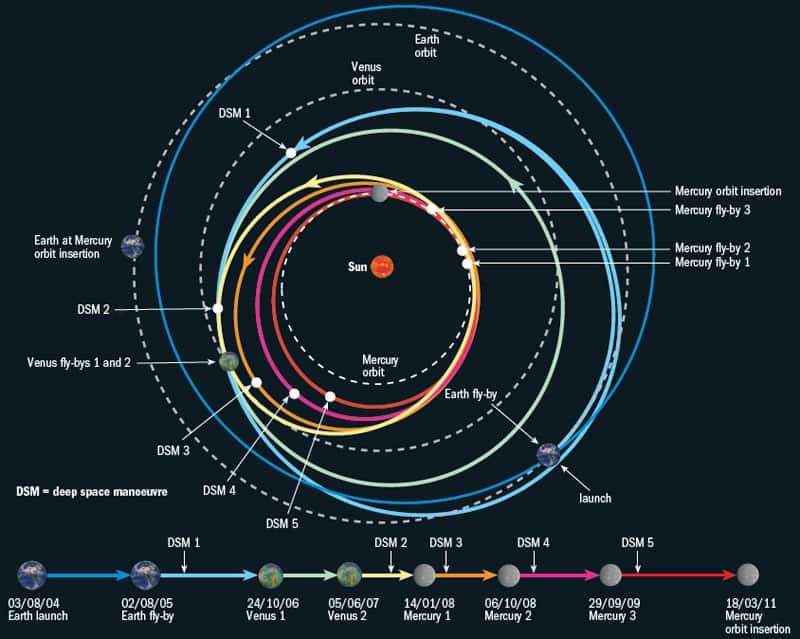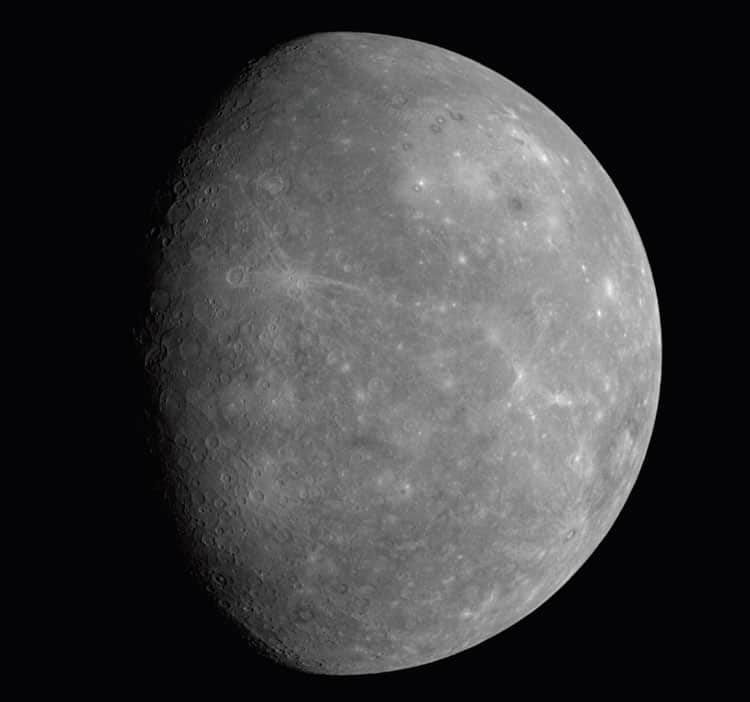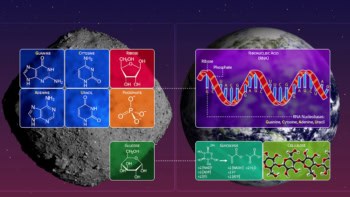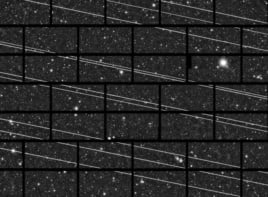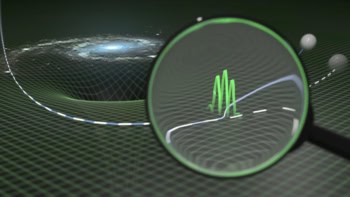In March the MESSENGER spacecraft is due to enter orbit around Mercury, the least studied planet in our solar system. Louise Prockter describes the mission's goals and the spacecraft's journey so far

“Eric, do we have anything yet? The suspense is killing me!” I say into the speakerphone. “I know, Louise, it’s killing us too, but still nothing,” replies Eric Finnegan, systems engineer for the MESSENGER mission. He sounds as calm and in control as ever; I, on the other hand, have been pacing up and down for several hours, not knowing quite what to do with myself.
It is about 6 p.m. on 15 January 2008 and Eric, the rest of the MESSENGER team and I are waiting for the first images from the planet Mercury in more than 30 years. The images are being beamed from the MESSENGER spacecraft – an object about half the size of a small car but with solar panels 6 m in length attached to it – across 171 million kilometres of space to antennas at NASA’s Deep Space Network. From there the images will travel to our Mission Operations Center at the Applied Physics Laboratory (APL) in Maryland, where Eric is waiting. Finally, the images will be sent to me and my colleagues in the Science Operations Center across the APL campus. They should have arrived about 10 hours ago, but because two other spacecraft declared emergencies this morning, all the antennas for the deep-space network that were supposed to be returning MESSENGER data have been temporarily pointed elsewhere. So, we must wait.
Waiting is not unusual in my business. You could say that we have been waiting almost 12 years for these images to arrive, ever since the MESSENGER mission was first proposed. You could even argue that we have waited more than three decades: the only other spacecraft to visit Mercury – Mariner 10 – flew by the planet three times in the mid-1970s but was only ever intended to be a reconnaissance mission to pave the way for a Mercury orbiter. So, these images have been a long time coming, and I should not complain.
For a planetary geologist like me, it is hard not to get excited about MESSENGER. Mariner 10 orbited the Sun, not Mercury, and its trajectory was such that it saw the same hemisphere of the planet each time it passed it. As a result, only 45% of Mercury was mapped, leaving the rest as terra incognita. Still, much was learned about the innermost planet, including the fact that it is unusually dense; it has a core that is far larger than predicted; quite unexpectedly, like the Earth it has a magnetic field, which may be internally generated; and it appears that of all the terrestrial planets (Mercury, Venus, Earth, Mars), Mercury’s geological activity ceased the earliest. We have learned a few things since Mariner 10 as well. In particular, radar observations from the Earth in the 1990s showed that some peculiar deposits, possibly ice, may exist in permanently shadowed regions at Mercury’s poles.
But despite these developments, the planet has remained one of the least studied in our solar system, and many questions about it remain. This is particularly surprising given that Mercury is a terrestrial body and as such it formed from similar materials to the Earth and the Moon. I have heard Mercury described as being like an eccentric neighbour who you see from time to time, but about whom you know next to nothing.
Preparing to fly
The MESSENGER mission was first proposed in 1996, and three years later was selected as part of NASA’s Discovery Program. The science goals proposed for the mission included investigating Mercury’s geological history, the nature of the strange radar-reflective deposits at the poles, the planet’s magnetic field and interior structure, the reasons for its high density, and the nature of its tenuous atmosphere.
At the time, I was still a planetary-geology graduate student, cutting my teeth on data from the Galileo mission to Jupiter and barely thinking about anything that was not an icy satellite. Projects in this field tend to have very long lives, and it is not uncommon for those who work on a mission to join it at different stages during its lifetime. So, I was a comparative latecomer to MESSENGER, beginning work on the mission in 2001 as a postdoctoral researcher at APL.
The mission’s principal investigator, Sean Solomon, is based at the Carnegie Institution of Washington, but staff at APL designed and built the spacecraft and several of its instruments, and APL manages the mission. Initially, I worked as a deputy instrument scientist for the onboard cameras, but after a couple of years I took over the role of instrument scientist. Each of the seven instruments on MESSENGER has an instrument scientist associated with it, and they are responsible for taking the requirements from the mission’s science team – experts in numerous different aspects of Mercury science – and making sure that their instruments (and, to some extent, the spacecraft) are capable of meeting those goals.
Although my background is in geology and geophysics, working as an instrument scientist on the two cameras that comprise MESSENGER’s imaging system required me to get “down in the weeds”, learning more about instrument design, software, and spacecraft guidance and control than I ever imagined possible. In the years before launch, I wrote and revised countless documents, learned all the gory details about how the cameras worked, figured out how to assemble sequences of software code to command the instrument, and attended numerous meetings and reviews. Somehow, over the years, everything – subsystems, instruments and spacecraft – came together, until finally the whole assembly could be tested to make sure it could withstand the intense heat of Mercury and the deep cold of space, as well as the vibrations of launch.
Building any spacecraft is a challenging and risky business. If anything goes wrong after launch, you have only limited resources available to address the problem. But building a spacecraft that can orbit Mercury for one year – the standard length of a mission in NASA’s Discovery Program – is particularly challenging, given Mercury’s proximity to the Sun. Mercury’s average orbital distance from the Sun is about 58 million kilometres, and at that distance the solar radiation is 11 times more intense than it is on the surface of the Earth. Any spacecraft in orbit around Mercury must therefore be able to withstand significant thermal variations. Temperatures reach approximately 425 °C on Mercury’s sunlit surface, which is hot enough to melt zinc, but they also dip as low as –185 °C on its night side.
These thermal variations have driven both the design of the spacecraft and the planned shape of its orbit around Mercury. The spacecraft carries a 2.5 × 2.0 m sunshield made of a heat-resistant ceramic cloth, similar to the material that protects the tiles on the Space Shuttle. The sunshade is positioned such that it shields and protects almost all the instruments and subsystems – the temperature on the front of the sunshade can reach a scorching 370 °C, but behind it everything remains essentially at room temperature. However, in order for this protection to be useful, the sunshade obviously needs to be pointed at the Sun at all times, which limits the pointing range of the spacecraft’s instruments. Although it can be rotated a few degrees side to side and up and down, the spacecraft is primarily fixed in space and must orbit Mercury in this configuration – a constraint that creates some interesting challenges when trying to point instruments at the planet. MESSENGER’s laser altimeter, for example, is fixed in one position on the spacecraft, and it cannot always aim at the planet without moving the sunshade sideways and risking overheating.
The Sun, however, is not the spacecraft’s only heat problem. Mercury’s surface radiates solar heat back into space, and any spacecraft that hopes to fly over it and come out intact must take this into account. MESSENGER will address the problem of reflected radiation by staying in a highly elliptical orbit that ranges from an altitude of ~200 km at its closest point, about 25–30 degrees south of Mercury’s north pole, to about 15,000 km at its furthest point, 180 degrees away. This means that MESSENGER will not get as hot as it would if it were in a circular orbit close to the planet’s surface.
But while this elliptical orbit will help prevent the spacecraft from overheating, it will also make data acquisition difficult. Some instruments, such as the magnetometer and particle spectrometers, are measuring the in situ environment and will be able to make measurements wherever they are. Remote sensing in_struments generally need to be pointed at the planet, however, and some can only take data when they are close to it. For example, MESSENGER’s laser altimeter can only range to the surface when it is below an altitude of about 1800 km, and so can only make topographic maps of the northern hemisphere since the chosen orbit simply does not allow it to “reach” the southern hemisphere.
Launch day and beyond
After hundreds of people worked for thousands of hours building the spacecraft’s hardware and instruments; developing power, communication, propulsion, thermal and software systems; planning every detail of the spacecraft’s trajectory and how it would accomplish its science objectives; and generally not getting much sleep, it was 3 August 2004 and we were finally ready for launch. This was actually our second attempt to launch the spacecraft – the previous night’s attempt was cancelled at the last minute because of concerns about the weather – but now everything was looking good.
I was lucky enough to watch the launch from a beach near Cape Canaveral in Florida. Many MESSENGER team members were at the official launch site, but I had heard that the view from the shore was just as good and did not require one to be in position hours ahead of time, as was the case at the official viewing site. A lot of the MESSENGER engineers – seasoned launch veterans – were at the beach too, so there was quite a party atmosphere despite the fact that it was 2 a.m.
The launch went flawlessly, and MESSENGER was on its way to Mercury, albeit by a circuitous route. At the advent of the space age, it was thought that getting to Mercury was simply too difficult, because the Sun’s mighty gravitational pull implied that prohibitive quantities of fuel would be needed to get into orbit around the innermost planet. It was not until the 1960s that engineers at the Jet Propulsion Laboratory in Pasadena, California, discovered that the gravity of a planet could be used to help tweak a spacecraft’s orbit in one direction or another, depending on the angle of approach and the spacecraft’s velocity.
This slingshot approach, termed a “gravity assist”, can save a significant amount of fuel and is now commonly used by spacecraft missions, including MESSENGER. The downside of this approach is that it takes time. In order for MESSENGER to reach orbit around Mercury, six gravity assists are needed: Earth (once), Venus (twice) and Mercury (three times). All in all, it will have taken six and a half years to get MESSENGER in the right place at the right time – and travelling at the right velocity – to fire its motor and get captured in Mercury’s orbit (see “A sightseeing tour with a purpose”).
On the plus side, fly-bys of planets or other bodies offer tremendously useful opportunities for practising spacecraft operations and testing subsystems and instruments. The extra time also allows calibrations to be carried out, software for data analysis to be developed, and all manner of issues to be identified and resolved. In the case of MESSENGER, the fly-bys have also yielded a huge amount of new data – particularly after 14 January 2008, the day of the first Mercury fly-by.
Back to the big day
And so I found myself waiting on that evening back in 2008, pacing up and down as I anticipated the arrival of the images from that first fly-by. Our Science Operations Center, or SOC, and the surrounding corridors and rooms were full of science team members, APL managers, educators and members of the press. The fly-by itself had taken place on the afternoon of the previous day: the closest approach, 200 km from Mercury’s surface, occurred at 2 p.m. EST, and the radio signals we had received back from the spacecraft suggested that everything had gone well. It appeared that the spacecraft had received a perfect gravity assist and was right on target, and all the instruments had taken data exactly as planned. Now we were waiting for images to be processed onboard the spacecraft, and for them to get sent back to Earth, to the Mission Operations Center, then finally to the SOC.
The images we were expecting were of the hemisphere of Mercury that no-one had ever seen before, part of the 55% of the planet that Mariner 10 had not been able to observe. This is in itself thrilling – how often in your life do you get to see something completely unexplored? But as the instrument scientist, my main concern at that moment was whether the two cameras had operated as expected and whether we had pointed them at the right place.
Our camera instrument engineer was sitting in front of one of the consoles in the SOC when, suddenly, the first image of Mercury appeared. My first feeling was one of complete joy and disbelief – a perfect, beautiful, gibbous Mercury filled the screen, showing an incredible level of detail. My second feeling was one of unabashed relief – the planet was perfectly centred in the image, so our pointing appeared to be spot-on and the instrument looked as if it was working perfectly. All those years of planning had paid off – we were finally taking images of Mercury! The whole room erupted into gasps, then cheers, and people started running in as they realized we had the first image on the ground. One of our science team members, septuagenarian Bob Strom, was a member of the original Mariner 10 science team and at times had doubted that he would ever see new images of Mercury. He was teary eyed as he looked at the screen. The rest of the evening was a happy, chaotic time, with numerous visitors coming in and out of the SOC, new images arriving and calls for press interviews.
Since that time we have completed two additional fly-bys of Mercury. The data collected from the three fly-bys have led to many discoveries and more than 60 scientific papers have already been published. Among other things, we have learned that Mercury’s volcanism persisted for far longer than previously thought, and we have evidence that some of it was explosive, giving clues to the amount and types of volatile gases in Mercury’s interior. We have confirmed that Mercury’s surface contracted globally as the planet cooled, and because MESSENGER has flown by both hemispheres of the planet, we now have a global view of the geometry of Mercury’s internal magnetic field. We also know more about how materials such as sodium and calcium are stripped away from Mercury’s surface by processes such as interaction with the solar wind. All of this is not insubstantial, considering the real reason for the Mercury fly-bys was to tweak MESSENGER’s trajectory – indeed, the science is all gravy!
Now, we are preparing for the finale: MESSENGER is on its way to rendezvous with Mercury and, if all goes well, it will enter orbit on the evening of 17 March at just before 9 p.m. EST. The first two weeks of orbit will be used to test the spacecraft’s subsystems and instruments, and to make sure everything is working well in the more hostile thermal environment of orbit. Once everything is checked, we will start taking science data, building up strips of images and taking other data day-by-day for a year. By then, MESSENGER will have gathered enough information to answer questions about Mercury’s origin, composition, interior structure and geological history – the real heart of the mission.
Postscript
In November 2010 I was returning from a business trip with a colleague who also works on the MESSENGER project. We had landed at Washington, DC’s Dulles airport and were on our way to collect our bags in the main terminal. Dulles recently built a new train to transport passengers between the terminals, and we were walking down a long, wide, well-lit tunnel towards the platform. When the train service opened, the walls of the tunnel were covered with large and beautiful photographs of Washington, DC, presumably intended to welcome visitors to our nation’s capitol. On this occasion, a new exhibition was on display: gorgeous photographs of the planets in our solar system. And there, right in the centre of the group, was MESSENGER’s first image of Mercury, as sharp and striking as when we first saw it, helping the planet to take its rightful place at last.
• For an audio interview with MESSENGER principal investigator Sean Solomon – and a report on the craft’s successful insertion into orbit around Mercury – click here

